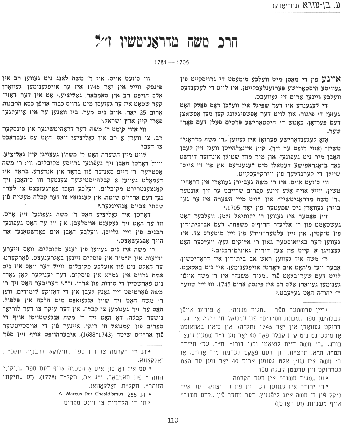
[ Page 113 ]
PART TWO
[ Page 114 ]
Mishnat Chassidim, that was incomprehensible even to experts in kabbalah.
R. Moshe undertook to explain that book to its readers. R. Moshe completed that task with his commentary, Magid Chassidim, on the book, Mishnat Chassidim. He received the approbations for his work from R. Yechezkel Landau, the author of Nodah Be'Yehudah as well as other esteemed scholars of that time.
Rabbi Moshe's commentary, Magid Mishnah, was very popular, and the Belzer Rebbe, R. Shalom, used to study it daily. Rabbi Moshe wasn't very pleased with his commentary, Magid Mishnah, because he felt that there were gaps here and there in the commentary, and in 1765 he published Kiryat Arba, a continuation of his earlier book. The second work also received the approbation from none other than the great kabbalist, Rabbi Zvi Hirsh of Zidichov, who praised him repeatedly in his own book, Pri Kodesh Hillulim. The book, Kiryat Arba was a widely-used text, and it went out of print very quickly.
2.
As discussed earlier, R. Moshe studied Jewish law extensively. In this area as well, R. Moshe did not lag behind. He wrote novellae commentaries on difficult sections of the Talmud, and clarified certain difficult sections of the commentaries of Tosafot and of Maimonides on the Talmud. His commentaries were published in his book, Chilukei de-Rabbanan, to which the greatest rabbis gave their approbations.
The title page of the book indicates a number of significant details about R. Moshe: first of all, two or three years after he published Kiryat Arba, (1765) and his other book, Chilukah de-Rabbanan (1768), R. Moshe became very ill, and only recovered miraculously. During that illness, he was given the added name of “Yosef.” This is certainly a hint to the verse in Isaiah 38:5, I shall add [yosef] to your days. Not only did his name change, but he changed as well. The event was an impetus for his to publish his book on Jewish law, Chilukah de-Rabbanan.
The same title page indicates that R. Moshe authored a work called Beit Tefilah, in which he discussed the importance of prayer according to the Lurianic system. However, the book was never printed. Another of his books that was never printed was Merkavat Mishnah, which deals with Jewish law and the writings of Maimonides.
In addition to that halachic work, R. Moshe also had a manuscript of a small treatise called Mar'eh Ofanim, in which he dealt with astronomy and the laws regarding the sanctification of the new month according to Maimonides. R. Moshe was very interested in astronomy because it is possible to understand the greatness of G-d through it. The treatise was held in high esteem by rabbis of that period. Nevertheless, only a small part of the Mar'eh Ofanim was published.
Rabbi Moshe evidently sought to distance himself from disputes. We don't find him to be involved in the dispute regarding the divorce certificate of Kleva. He was also not among the supporters or opponents of R. Yonatan Eibschutz and R. Yaakov Emden.
Rabbi Moshe was involved in his talmudic and kabbalistic studies, and therefore stayed away from disputes even when they involved the greatest rabbis of his generation, and who were among his friends and associates.
Previous Page
|
Next Page
JewishGen, Inc. makes no representations regarding the accuracy of
the translation. The reader may wish to refer to the original material
for verification.
JewishGen is not responsible for inaccuracies or omissions in the original work and cannot rewrite or edit the text to correct inaccuracies and/or omissions.
Our mission is to produce a translation of the original work and we cannot verify the accuracy of statements or alter facts cited.
 Drogichin, Belarus
Drogichin, Belarus
 Yizkor Book Project
Yizkor Book Project
 JewishGen Home Page
JewishGen Home Page
Copyright © 1999-2025 by JewishGen, Inc.
Updated 10 Dec 2001 by LA